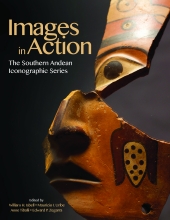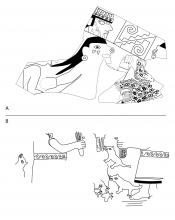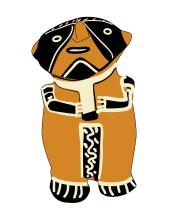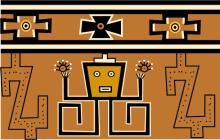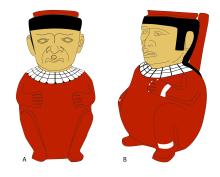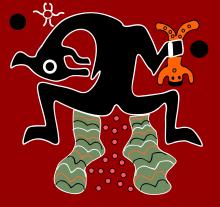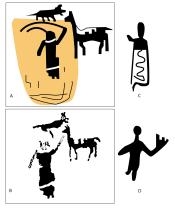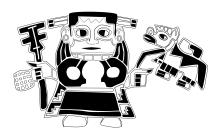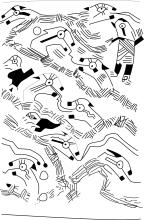Visual database
Images of mythical mothers from the Wari site of Conchopata. (a) Image painted on an urn showing a female figure with camelid attributes suckling a young feline (adapted and redrawn from Isbell and Cook 2002). (b) Image from a second urn depicting two female figures feeding human body parts to a pack of hungry canines and birds (adapted and redrawn from Cook 2004).
Drawing of a Wari tapestry fragment from Peru's Museo Nacional with an anthropomorphic version of Sawyer's "composite motif." The raised arms and curled lower limbs are suggestive of a squatting pose, often used in childbirth. The mirror reflection of the figure, one head-up, the other head-down, creates an image of the figure giving birth to itself. Drawn from photograph of registry 2329, colors approximate.
Coastal Wari figurine, Huara style, from the Arthur M. Sackler collection, accession N-94. Katz describes the figure as an anthropomorphic feline, but the human-like arms, legs, and face suggest that the figure is intended to represent a person. The zigzag line on the front panel may represent the flow of menstrual blood, marking the figure as female. Drawn from photograph (Katz 1983:Plate 158), colors approximate.
Decoration on Tumilaca kero, on display in the Museo Contisuyu, Moquegua. It depicts an anthropomorphic being with curled lower limbs similar to those on the Wari tapestry fragment in Figure 20.9, arguably an abstract representation of the "partuition pose." Accompanying geometric motifs such as the crosses with circle-dot centers and the Z-shaped meander may have imparted additional meaning to the original audience. Drawn from photograph (Goldstein and Rivera 2004), colors approximate.
Drawing of a pair of spouted effigy vessels from Tiwanaku site of Pariti. The broad collars, blunt haircuts, and labretted upper lips make them very different from other representations of Tiwanaku people in the Lake Titicaca Basin, suggesting they represent members of a different ethnic group. Ceramic material, red slip paint, and careful sculpting of the faces mark these as Tiwanaku pieces. Discovered as a pair, they were described as a man (a) and a "fat man" (b). Long hair visible falling down the back of the second figure, bracelets, anklets, and the different stance, however, make it reasonable to "read" the second figure as female who is pregnant, not fat. Based on photos by A. Korpisaari (Korpisaari and Parssinen 2005:Photos 10 and 11). Colors approximate.
Drawing of an anthropomorphic camelid birthing a human infant from a ch'allador found at Pariti. Reminiscent of the pooled blood on the Siguas textile in Figure 20.5 and the zigzag lines of blood illustrated on the figurine in Figure 20.10, blood (and/or amniotic fluid or placental matter) flows down from between the camelid-mother's squatting, anthropomorphic legs. Based on a photo by A. Korpisaari (Korpisaari and Parssinen 2005:Photo 40). Color approximate.
Anthropomorphic images from Pignasi, Bolivia. (a, b) Female figures in long dresses accompanied by a camelid and canine; (c) also appears to be wearing a long dress. Figure (d), although of ambiguous sex, is spatially associated with another camelid-like animal as part of the same panel as figures (a) and (c). Adapted and redrawn from Cruz (2006). Color approximate.
The Pucara Camelid Woman theme is the quintessential representation of the association between females and domesticated camelids and seems to anticipate Colonial era accounts of puna-bound women herding their llamas and alpacas. Typically, she leads a single llama with her left hand and holds a basket (of food? of wool?) and long staff. The divided eye may attest to her supernatural characteristics or mark her as an important culture hero figure. Adapted and redrawn from Chávez (2002).
Siguas I pyroengraved canes often depict rather abstract anthropomorphic and zoomorphic forms. On this fragment, the long necks of the animals allow us to recognize them as camelids. Two black-bodied birds are also shown. The one-eyed figure in the upper right corner appears to have a beak and could represent an anthropomorphic bird creature. Human figures in the Siguas tradition, however, often appear to wear elaborate headdresses or masks with rayed projections or horns, and this would appear to be such a case. While the level of abstraction makes it difficult to say much about this figure, it may represent a Siguas version of the "woman with camelid" theme. Adapted and redrawn from Haeberli (2002).
Textile from Ocoña, Peru, is decorated in yellow and blue macaw feathers depicting two anthropomorphic beings with three camelids. The animals appear to be domesticated as one is attached to the human figure by a leash. The human figures are of ambiguous sex but may represent women based on the association of women and domesticated camelids in SAIS iconography. Drawn from photo (Bonavia 1994:211, Plate 162). Colors approximate.
